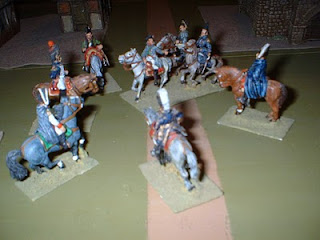
Prior to the battle the French have identified the British locations.
The British (top) start the game with figures on the table
The French (bottom) start the game with skirmish blinds on the table
Equipment
Each player will need the following equipment
One average dice
One 10 sided dice
A few six sided dice
A measure
An order sheet and order of battle
A card or poker chip for each commander
Place Blinds on the table
Hidden movement is optional, but can add an extra dimension to the rules.
Each commander is represented by a “blind” This can be an oblong card 6x3” or it can be a skirmish base. It shows where the head of the corps is, and the width.
Blinds are placed on the table before the game starts. In a campaign game one side may know the location and strength of the other due to overwhelming cavalry superiority. In this case the “spotted” side will place figures on the table and the other side place blinds.
There are five blinds, six if you have a cavalry or artillery reserve.
One for each corps commander and one for the CinC. This is to make it more difficult for the enemy to guess where your real strength lies.
The blind is replaced with the figures when it has been spotted by the enemy (see rule 1)
The frontage of the corps is the same as the blind.
One blind means that the corps is in column of march.
You can extend by one blind each move, and the more blinds the wider your initial deployment.
Writing Orders
Each player writes orders for all of his corps commanders before the game starts (see rule 4).
These orders prevent the corps commander from reacting to what is happening on the table.
These orders can only be changed by the CinC during his move, and he must be in base contact with the corps commander to do so (see rule 2)
Commanders Cards
You will need a number of cards or poker chips to decide sequence of play
One card for each commander
One French Gifted card
One Allied Gifted card
One Poor card
The cards are shuffled and drawn one at a time.
When a commanders card is drawn he takes his turn
When a Gifted card is drawn any Gifted player may take his turn
When a Poor card is drawn the next Poor commander to draw his card must miss his go
Sequence of Play
All artillery fire
Morale for any casualties due to artillery fire
All movement
All combat
Morale for any casualties due to combat
Morale for any Routed or Shaken brigades
Command Points
CinC rolls an average dice at the start of his turn
He adds 1 if Poor, 2 if Average and 3 if Gifted
These are his Command Points (see rules 2 and 3)
Each corps commander gets 1 point for each brigade not shaken or in rout
He adds 1 if Poor, 2 if Average and 3 if Gifted
The total determines the number of orders he can issue during his turn







